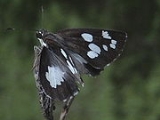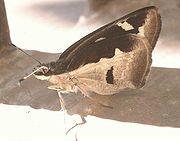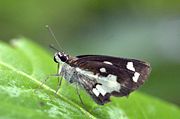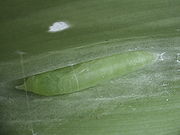
Udaspes folus
Encyclopedia
The Grass Demon Udaspes folus is a small but prominent butterfly found in India that belongs to the Skippers, or Hesperiidae family. It is regarded as an occasional pest of ginger and turmeric.
with a wingspan of about 4 to 4.8 cm. It is black with a large white spot on the upperside of the hind wing and several smaller whites spots on the forewing. The underside of its wings is mostly white with brown edges and spots.

It is a bold insect and not easily disturbed. It usually flies in the shade among bushes and under trees keeping low and close to the ground. From time to time, it takes short flights, and, occasionally, much longer excursions into the open clearings. Its flight is quick and the path is very erratic making it very difficult to track when in flight.
 When basking it sits on the upperside of leaves of herbs or bushes with its hind wings pressed flat against the surface and its fore wings held half open at an angle above the hind wings.
When basking it sits on the upperside of leaves of herbs or bushes with its hind wings pressed flat against the surface and its fore wings held half open at an angle above the hind wings.
This butterfly also has a unique wing flashing display most often seen just after it has alighted on a leaf. It will move its hind wings down toward the leaf surface. When the hind wings are about half way down the fore wings also start moving downwards. On the upward beat both wings are moved simultaneously till the hind wings come together. Then it again begins the downward beat. Each beat is performed very slowly and the butterfly is very conspicuous during this time.
This display is unique since no other peninsular Indian butterfly is known to display the capability of moving forewings and hindwings separately.
The Grass Demon is a nectar lover and has a long proboscis
compared to body size. This makes it easy to get to nectar of flowers with long corolla tubes. In gardens, the Common Periwinkle (Vinca rosea) and Lantana
are its favourite flowers. It rarely visits bird or dung droppings. It is fond of water and often seen perched on a stone in a stream-bed.
. The egg is reddish and appears smooth and dome shaped. When about to hatch it turns white with a red top.

Soon after hatching, the caterpillar does not consume the eggshell completely and it makes itself a spacious cell and hides inside it. The caterpillar is sluggish and comes out to feed only at night. Even when disturbed it is reluctant to leave its cell.
The caterpillar
is a light uniform leaf green color with a dark green pulsating line on the back and a relatively small, dark head. The full grown larva has the habit of resting with the first three segments contracted, so as to give a humped appearance. It always lies closely applied to the leaf, by turning over a triangular piece from the edge onto the upper surface over itself. Specific host plants include Zingiber zerumbet
.
 Pupation takes place on the same plant within a cell. The pupa
Pupation takes place on the same plant within a cell. The pupa
is long and cylindrical, watery green in colour. It has a long conical projection in front of the head. The eyes are easily seen but do not protrude out of the outline of the pupa. The pupa broadens towards the shoulders and the abdomen gradually tapers to the last segment.
The most striking characteristic of the pupa is its proboscis. It is long and thin generally extending up to and a little beyond the tip of the abdomen. The pupa is the same color of the caterpillar and unmarked. It is covered in a thin layer of white powder. The body band is neither too tight nor too loose and allows the pupa to wriggle if disturbed.
, turmeric
, and their relatives Curcuma aromatica
, Curcuma decipiens, Hedychium sp.
and other plants of Family Sctiaminae. It has also been recorded on Zingiber sp.
and on Grasses.
Description
The Grass Demon (Udaspes folus) is a small butterflyButterfly
A butterfly is a mainly day-flying insect of the order Lepidoptera, which includes the butterflies and moths. Like other holometabolous insects, the butterfly's life cycle consists of four parts: egg, larva, pupa and adult. Most species are diurnal. Butterflies have large, often brightly coloured...
with a wingspan of about 4 to 4.8 cm. It is black with a large white spot on the upperside of the hind wing and several smaller whites spots on the forewing. The underside of its wings is mostly white with brown edges and spots.
Range
Sri Lanka, South India to Saurashtra, Maharashtra, Gujarat, Madhya Pradesh, Uttar Pradesh, West Bengal, Himachal Pradesh to North East India and onto Myanmar. China. Thailand. Malayasian Peninsula. Indonesia, Sumbawa. Australia.Status
Not Rare in India. Rare or Very Rare in certain parts of its global range. This butterfly is seen chiefly during the monsoon, perhaps due to its larval host plants growing at this time of the year.Habitat
The Grass Demon is to be found in deciduous and semi-evergreen forests. It prefers the edges of open spaces rather than the deep forest shade or open sunlight. It is most abundant in the more open regions of hilly jungle. It is also encountered on the plains at some distance from such terrain. It occurs up to 8000 feet in the hills of South India and up to 5000 feet in the Himalayas.
Habits
The Grass Demon prefers forest edges or clearings where dappled light is present. Its black and white colouration may have evolved to take advantage of the dappled light in these areas. The pied pattern which seems prominent in the open is effectively disruptive in the shade and the butterfly is difficult to locate once it settles down.It is a bold insect and not easily disturbed. It usually flies in the shade among bushes and under trees keeping low and close to the ground. From time to time, it takes short flights, and, occasionally, much longer excursions into the open clearings. Its flight is quick and the path is very erratic making it very difficult to track when in flight.

This butterfly also has a unique wing flashing display most often seen just after it has alighted on a leaf. It will move its hind wings down toward the leaf surface. When the hind wings are about half way down the fore wings also start moving downwards. On the upward beat both wings are moved simultaneously till the hind wings come together. Then it again begins the downward beat. Each beat is performed very slowly and the butterfly is very conspicuous during this time.
This display is unique since no other peninsular Indian butterfly is known to display the capability of moving forewings and hindwings separately.
The Grass Demon is a nectar lover and has a long proboscis
Proboscis
A proboscis is an elongated appendage from the head of an animal, either a vertebrate or an invertebrate. In simpler terms, a proboscis is the straw-like mouth found in several varieties of species.-Etymology:...
compared to body size. This makes it easy to get to nectar of flowers with long corolla tubes. In gardens, the Common Periwinkle (Vinca rosea) and Lantana
Lantana
Lantana is a genus of about 150 species of perennial flowering plants in the verbena family, Verbenaceae. They are native to tropical regions of the Americas and Africa but exist as an introduced species in numerous areas, especially in the Australian-Pacific region. The genus includes both...
are its favourite flowers. It rarely visits bird or dung droppings. It is fond of water and often seen perched on a stone in a stream-bed.
Life cycle
The butterflies emerge in February or March and lay eggs before they die. The eggs remain dormant till the rains, that is, usually the month of May, when they hatch. The caterpillars pupate in September-October and the adults emerge four to six months later. In some cases the caterpillars pupate later and in these cases the pupa remain dormant, throughout the dry season, till May when the rains begin.Eggs
The female normally sits on the underside of the leaf of the host plant and lays a single eggEgg (biology)
An egg is an organic vessel in which an embryo first begins to develop. In most birds, reptiles, insects, molluscs, fish, and monotremes, an egg is the zygote, resulting from fertilization of the ovum, which is expelled from the body and permitted to develop outside the body until the developing...
. The egg is reddish and appears smooth and dome shaped. When about to hatch it turns white with a red top.
Larva

Soon after hatching, the caterpillar does not consume the eggshell completely and it makes itself a spacious cell and hides inside it. The caterpillar is sluggish and comes out to feed only at night. Even when disturbed it is reluctant to leave its cell.
The caterpillar
Caterpillar
Caterpillars are the larval form of members of the order Lepidoptera . They are mostly herbivorous in food habit, although some species are insectivorous. Caterpillars are voracious feeders and many of them are considered to be pests in agriculture...
is a light uniform leaf green color with a dark green pulsating line on the back and a relatively small, dark head. The full grown larva has the habit of resting with the first three segments contracted, so as to give a humped appearance. It always lies closely applied to the leaf, by turning over a triangular piece from the edge onto the upper surface over itself. Specific host plants include Zingiber zerumbet
Zingiber zerumbet
Zingiber zerumbet Sm., also known as the Shampoo Ginger, is a vigorous ginger with leafy stems growing to about 1.2 m tall. It is found in many tropical countries. The rhizomes of Z...
.
Pupa

Pupa
A pupa is the life stage of some insects undergoing transformation. The pupal stage is found only in holometabolous insects, those that undergo a complete metamorphosis, going through four life stages; embryo, larva, pupa and imago...
is long and cylindrical, watery green in colour. It has a long conical projection in front of the head. The eyes are easily seen but do not protrude out of the outline of the pupa. The pupa broadens towards the shoulders and the abdomen gradually tapers to the last segment.
The most striking characteristic of the pupa is its proboscis. It is long and thin generally extending up to and a little beyond the tip of the abdomen. The pupa is the same color of the caterpillar and unmarked. It is covered in a thin layer of white powder. The body band is neither too tight nor too loose and allows the pupa to wriggle if disturbed.
Food plants
The Grass Demon feeds on gingerGinger
Ginger is the rhizome of the plant Zingiber officinale, consumed as a delicacy, medicine, or spice. It lends its name to its genus and family . Other notable members of this plant family are turmeric, cardamom, and galangal....
, turmeric
Turmeric
Turmeric is a rhizomatous herbaceous perennial plant of the ginger family, Zingiberaceae. It is native to tropical South Asia and needs temperatures between 20 °C and 30 °C and a considerable amount of annual rainfall to thrive...
, and their relatives Curcuma aromatica
Curcuma aromatica
Curcuma aromatica is a member of the Curcuma genus belonging to the family Zingiberaceae. Botanically close to Curcuma australasica, wild turmeric has been widely used as a cosmetic herbal in South Asia and nearby regions.- Nomenclature :* Common name in English: wild turmeric, aromatic turmeric*...
, Curcuma decipiens, Hedychium sp.
Hedychium
Hedychium is a genus of perennial plants native to tropical Asia and the Himalayas, commonly growing to between 120 and 180 cm tall. Common names include garland flower, ginger lily, and kahili ginger...
and other plants of Family Sctiaminae. It has also been recorded on Zingiber sp.
Zingiber
The genus Zingiber contains the true gingers, a set of plants with medicinal and culinary value in many parts of the world. The most well-known is Z. officinale, garden ginger.-Culinary:...
and on Grasses.

